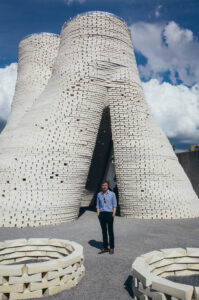I’ve always been obsessed with design and interiors, and as I’ve moved between different houseshares, the styling of my bedroom has become a paramount project. It’s a form of self-expression, and creating an enjoyable intimate space feels like a small victory in an era that can often feel so tumultuous and disempowering, especially concerning Covid-19, the climate crisis, and more recently, the rising cost of living. But an important question, in the face of the current climate crises, is how can we minimise material waste and think more consciously about sustainable living practices?
Researchers at the University of Nairobi have found that we are seeing a societal shift to integrate environmentally sustainable practices as people are starting to recognize the link between “spaces, people and the community.”
This thinking inspires us to hold big business and industry accountable for environmental harm and challenges the misconception that public behaviour is solely responsible for the polluted built environments we inhabit. While we can all make differences in adopting greener behaviours, change fundamentally happens in the macro fields of environmental damage as opposed to micro ones.
This is where mushrooms make another compelling case. Mycelium, an offshoot of fungus, has gained traction in recent years as a sustainable material and is being used in the construction, architecture, and interior design industries. The construction industry is developing science-led innovations that will enable the roots of mushrooms, which consist of minuscule threads called hyphae, to become adopted and widespread in building initiatives.
The key reason for this technological drive is that mushrooms are sustainable. If we grow our bricks and boards from mycelium and fill it with agricultural waste, it takes days for the mushroom spores to absorb the organic matter into a viable solid, a process that is affordable and efficient. Mycelium is highly versatile and helps replace the use of harmful plastics. Researchers with Scientific American argue that biological technology is the most persuasive direction we must take to harmonize our built relationship with Earth.
The architectural firm The Living broke new ground with their sustainably made mushroom brick tower the “Hy-Fi”, which debuted at MoMA’s courtyard space in Manhattan in 2014. When the tower was dismantled two months later, each brick was taken to compost.

Architects were first inspired to use mushroom roots by biodegradable waste packaging initiatives that used mycelium. The drawback of using mushroom root in construction is the strength of the material. Although its function is proven in interior design fields and as an insulation material, it falls short in areas where structural proficiency is the end goal. Researchers are currently refining products to enable the material to be weight-bearing, which will diversify its use. The construction industries currently contribute to around a tenth of global carbon dioxide emissions and this isn’t improving without the integration of unconventional and grown materials which will steer industries away from factory-made fossil resources.
Additional work has been done exploring the benefit of mycelium in performing health and safety roles in buildings for its natural fire retardant properties. After the tragedy of the Grenfell Tower fire in 2017, fire cladding entered public discourse for important reasons highlighting both government and construction failures. The subsequent inquiry concluded that the use of polymers such as polyethene incorporated aluminium composite in panels resulted in hazardous smoke inhalation that was mostly responsible for the 72 lives lost. Reports and quality laboratory testing proceed to strengthen the case of mycelium as a new sustainable and fire-impeding biomaterial, which is carbon-negative, meaning it confiscates more atmospheric carbon than it releases over its lifecycle.

In the spheres of our built world, mycelium provides hope and solutions to our pressing climate concerns. Through harnessing the powerful relationship between bioscience, innovation and design researchers and practitioners are showcasing what’s possible if we invest time and money into sustainable alternatives.













